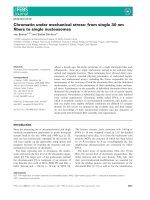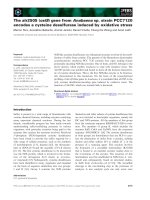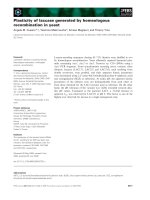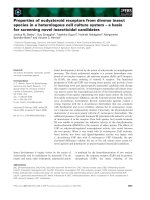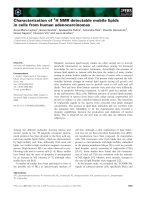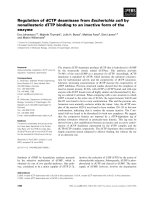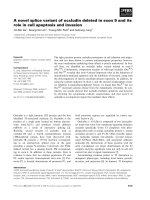Tài liệu Báo cáo khoa học: "Generating statistical language models from interpretation grammars in dialogue systems" potx
Bạn đang xem bản rút gọn của tài liệu. Xem và tải ngay bản đầy đủ của tài liệu tại đây (78.87 KB, 8 trang )
Generating statistical language models from interpretation grammars in
dialogue systems
Rebecca Jonson
Dept. of Linguistics, G
¨
oteborg University and GSLT
Abstract
In this paper, we explore statistical lan-
guage modelling for a speech-enabled
MP3 player application by generating a
corpus from the interpretation grammar
written for the application with the Gram-
matical Framework (GF) (Ranta, 2004).
We create a statistical language model
(SLM) directly from our interpretation
grammar and compare recognition per-
formance of this model against a speech
recognition grammar compiled from the
same GF interpretation grammar. The
results show a relative Word Error Rate
(WER) reduction of 37% for the SLM
derived from the interpretation grammar
while maintaining a low in-grammar WER
comparable to that associated with the
speech recognition grammar. From this
starting point we try to improve our arti-
ficially generated model by interpolating
it with different corpora achieving great
reduction in perplexity and 8% relative
recognition improvement.
1 Introduction
Ideally when building spoken dialogue systems,
we would like to use a corpus of transcribed di-
alogues corresponding to the specific task of the
dialogue system, in order to build a statistical lan-
guage model (SLM). However, it is rarely the case
that such a corpus exists in the early stage of
the development of a dialogue system. Collect-
ing such a corpus and transcribing it is very time-
consuming and delays the building of the actual
dialogue system.
An approach taken both in dialogue systems
and dictation applications is to first write an in-
terpretation grammar and from that generate an
artificial corpus which is used as training corpus
for the SLM (Raux et al, 2003; Pakhomov et al,
2001; Fosler-Lussier & Kuo, 2001). These mod-
els obtained from grammars are not as good as the
ones built from real data as the estimates are arti-
ficial, lacking a real distribution. However, it is a
quick way to get a dialogue system working with
an SLM. When the system is up and running it
is possible to collect real data that can be used to
improve the model. We will explore this idea by
generating a corpus from an interpretation gram-
mar from one of our applications.
A different approach is to compile the interpre-
tation grammar into a speech recognition gram-
mar as the Gemini and REGULUS compilers do
(Rayner et al, 2000; Rayner et al, 2003). In this
way it is assured that the linguistic coverage of the
speech recognition and interpretation are kept in
sync. Such an approach enables us to interpret all
that we can recognize and the other way round. In
the European-funded project TALK the Grammat-
ical Framework (Ranta, 2005) has been extended
with such a facility that compiles GF grammars
into speech recognition grammars in Nuance GSL
format (www.nuance.com).
Speech recognition for commercial dialogue
systems has focused on grammar-based ap-
proaches despite the fact that statistical language
models seem to have a better overall performance
(Gorrell et al, 2002). This probably depends on
the time-consuming work of collecting corpora for
training SLMs compared with the more rapid and
straightforward development of speech recogni-
tion grammars. However, SLMs are more robust,
can handle out-of-coverage output, perform bet-
ter in difficult conditions and seem to work bet-
57
ter for naive users (see (Knight et al, 2001)) while
speech recognition grammars are limited in their
coverage depending on how well grammar writers
succeed in predicting what users may say (Huang
et al, 2001).
Nevertheless, as grammars only output phrases
that can be interpreted their output makes the fol-
lowing interpretation task easier than with the un-
predictable output from an SLM (especially if the
speech recognition grammar has been compiled
from the interpretation grammar and these are both
in sync). In addition, the grammar-based approach
in the experiments reported in (Knight et al, 2001)
outperforms the SLM approach on semantic error
rate on in-coverage data. This has lead to the idea
of trying to combine both approaches, as shown in
(Rayner & Hockey, 2003). This is also something
that we are aiming for.
Domain adaptation of SLMs is another issue
in dialogue system recognition which involves re-
using a successful language model by adapting it
to a new domain i.e. a new application (Janiszek et
al, 1998). If a large corpus is not available for the
specific domain but there is a corpus for a collec-
tion of topics we could use this corpus and adapt
the resulting SLM to the domain. One may as-
sume that the resulting SLM based on a large cor-
pus with a good mixture of topics should be able to
capture at least a part of general language use that
does not vary from one domain to another. We will
explore this idea by using the Gothenburg Spoken
Language Corpus (GSLC) (Allwood, 1999) and a
newspaper corpus to adapt these to our MP3 do-
main.
We will consider several different SLMs based
on the corpus generated from the GF interpreta-
tion grammar and compare their recognition per-
formance with the baseline: a Speech Recogni-
tion Grammar in Nuance format compiled from
the same interpretation grammar. Hence, what we
could expect from our experiment, by looking at
earlier research, is very low word error rate for
our speech recognition grammar on in-grammar
coverage but a lot worse performance on out-of-
grammar coverage. The SLMs we are consider-
ing should tackle out-of-grammar utterances bet-
ter and it will be interesting to see how well these
models built from the grammar will perform on
in-grammar utterances.
This study is organized as follows. Section 2
introduces the domain for which we are doing
language modelling and the corpora we have at
our disposal. Section 3 will describe the different
SLMs we have generated. Section 4 describes the
evaluation of these and the results. Finally, we re-
view the main conclusions of the work and discuss
future work.
2 Description of Corpora
2.1 The MP3 corpus
The domain that we are considering in this pa-
per is the domain of an MP3 player application.
The talking MP3 player, DJGoDiS, is one of sev-
eral applications that are under development in the
TALK project. It has been built with the TrindiKit
toolkit (Larsson et al, 2002) and the GoDiS dia-
logue system (Larsson, 2002) as a GoDiS appli-
cation and works as a voice interface to a graphi-
cal MP3 player. The user can among other things
change settings, choose stations or songs to play
and create playlists. The current version of DJ-
GoDiS works in both English and Swedish.
The interpretation and generation grammars are
written with the GF grammar formalism. GF is
being further developed in the project to adapt
it to the use in spoken dialogue systems. This
adaptation includes the facility of generating Nu-
ance recognition grammars from the interpretation
grammar and the possibility of generating corpora
from the grammars. The interpretation grammar
for the domain, written in GF, translates user utter-
ances to dialogue moves and thereby holds all pos-
sible interpretations of user utterances (Ljungl
¨
of
et al, 2005). We used GF’s facilities to generate a
corpus in Swedish consisting of all possible mean-
ingful utterances generated by the grammar to a
certain depth of the analysis trees in GF’s abstract
syntax as explained in (Weilhammer et al, 2006).
As the current grammar is under development it
is not complete and some linguistic structures are
missing. The grammar is written on the phrase
level accepting spoken language utterances such
as e.g. “next, please”.
The corpus of possible user utterances resulted
in around 320 000 user utterances (about 3 mil-
lion words) corresponding to a vocabulary of only
301 words. The database of songs and artists in
this first version of the application is limited to
60 Swedish songs, 60 Swedish artists, 3 albums
and 3 radio stations. The vocabulary may seem
small if you consider the number of songs and
artists included, but the small size is due to a huge
58
overlap of words in songs and artists as pronouns
(such as Jag (I) and Du (You)) and articles (such as
Det (The)) are very common. This corpus is very
domain specific as it includes many artist names,
songs and radio stations that often consist of rare
words. It is also very repetitive covering all com-
binations of songs and artists in utterances such as
“I want to listen to Mamma Mia with Abba”. All
utterances in the corpus occur exactly once.
2.2 The GSLC corpus
The Gothenburg Spoken Language (GSLC) cor-
pus consists of transcribed Swedish spoken lan-
guage from different social activities such as auc-
tions, phone calls, meetings, lectures and task-
oriented dialogue (Allwood, 1999). To be able
to use the GSLC corpus for language modelling
it was pre-processed to remove annotations and all
non-alphabetic characters. The final GSLC corpus
consisted of a corpus of about 1,300,000 words
with a vocabulary of almost 50,000 words.
2.3 The newspaper corpus
We have also used a corpus consisting of a col-
lection of Swedish newspaper texts of 397 million
words.
1
Additionally, we have created a subcor-
pus of the newspaper corpus by extracting only the
sentences including domain related words. With
domain related words we mean typical words for
an MP3 domain such as “music”, “mp3-player”,
“song” etc. This domain vocabulary was hand-
crafted. The domain-adapted newspaper corpus,
obtained by selecting sentences where these words
occurred, consisted of about 15 million words i.e.
4% of the larger corpus.
2.4 The Test Corpus
To collect a test set we asked students to describe
how they would address a speech-enabled MP3
player by writing Nuance grammars that would
cover the domain and its functionality. Another
group of students evaluated these grammars by
recording utterances they thought they would say
to an MP3 player. One of the Nuance grammars
was used to create a development test set by gen-
erating a corpus of 1500 utterances from it. The
corpus generated from another grammar written
by some other students was used as evaluation
test set. Added to the evaluation test set were the
transcriptions of the recordings made by the third
1
This corpus was made available by Leif Gr
¨
onqvist, Dept.
of Linguistics, G
¨
oteborg University
group of students that evaluated both grammars.
This resulted in a evaluation test set of 1700 utter-
ances.
The recording test set was made up partly of the
students’ recordings. Additional recordings were
carried out by letting people at our lab record ran-
domly chosen utterances from the evaluation test
set. We also had a demo running for a short time to
collect user interactions at a demo session. The fi-
nal test set included 500 recorded utterances from
26 persons. This test set has been used to com-
pare recognition performance between the differ-
ent models under consideration.
The recording test set is just an approximation
to the real task and conditions as the students only
capture how they think they would act in an MP3
task. Their actual interaction in a real dialogue
situation may differ considerably so ideally, we
would want more recordings from dialogue sys-
tem interactions which at the moment constitutes
only a fifth of the test set. However, until we can
collect more recordings we will have to rely on
this approximation.
In addition to the recorded evaluation test set,
a second set of recordings was created covering
only in-grammar utterances by randomly generat-
ing a test set of 300 utterances from the GF gram-
mar. These were recorded by 8 persons. This test
set was used to contrast with a comparison of in-
grammar recognition performance.
3 Language modelling
To generate the different trigram language models
we used the SRI language modelling toolkit (Stol-
cke, 2002) with Good-Turing discounting.
The first model was generated directly from the
MP3 corpus we got from the GF grammar. This
simple SLM (named MP3GFLM) has the same vo-
cabulary as the Nuance Grammar and models the
same language as the GF grammar. This model
was chosen to see if we could increase flexibility
and robustness in such a simple way while main-
taining in-grammar performance.
We also created two other simple SLMs: a
class-based one (with the classes Song, Artist
and Radiostation) and a model based on a
variant of the MP3 corpus where the utterances
in which songs and artists co-occur would only
match real artist-song pairs (i.e. including some
music knowledge in the model).
These three SLMs were the three basic MP3
59
models considered although we only report the re-
sults for the MP3GFLM in this article (the class-
based model gave a slightly worse result and the a
other slightly better result).
In addition to this we used our general corpora
to produce three different models: GSLCLM from
the GSLC corpus, NewsLM from the newspaper
corpus and DomNewsLM from the domain adapted
newspaper Corpus.
3.1 Interpolating the GSLC corpus and the
MP3 corpus
A technique used in language modelling to com-
bine different SLMs is linear interpolation (Jelinek
& Mercer, 1980). This is often used when the do-
main corpus is too small and a bigger corpus is
available. There have been many attempts at com-
bining domain corpora with news corpora, as this
has been the biggest type of corpus available and
this has given slightly better models (Janiszek et
al, 1998; Rosenfeld, 2000a). Linear interpolation
has also been used when building state dependent
models by combining the state models with a gen-
eral domain model (Xu & Rudnicky, 2000; Sol-
sona et al, 2002).
Rosenfeld (Rosenfeld, 2000a) argues that a lit-
tle more domain corpus is always better than a lot
more training data outside the domain. Many of
these interpolation experiments have been carried
out by adding news text, i.e. written language. In
this experiment we are going to interpolate our do-
main model (MP3GFLM) with a spoken language
corpus, the GSLC, to see if this improves perplex-
ity and recognition rates. As the MP3 corpus is
generated from a grammar without probabilities
this is hopefully a way to obtain better and more
realistic estimates on words and word sequences.
Ideally, what we would like to capture from the
GSLC corpus is language that is invariant from
domain to domain. However, Rosenfeld (Rosen-
feld, 2000b) is quite pessimistic about this, argu-
ing that this is not possible with today’s interpo-
lation methods. The GSLC corpus is also quite
small.
The interpolation was carried out with the
SRILM toolkit
2
based on equation 1.
M ixG S LC M P 3GF = λ ∗ M P 3GF L M + (1 − λ) ∗ GSLC LM
(1)
The optimal lambda weight was estimated to
0.65 with the SRILM toolkit using the develop-
ment test set.
2
as of 2005.
3.2 Interpolating the newspaper corpus and
the MP3 corpus
We also created two models in the same way as
above by interpolating the two variants of the news
corpus with our simplest model.
M ixN ew sM P 3GF = λ ∗ M P 3GF LM + (1 − λ) ∗ N ew sLM
(2)
M ixDomN ew sM P 3GF = λ∗M P 3GF LM +(1− λ)∗ D omN ew sLM
(3)
In addition to these models we created a model
where we interpolated both the GSLC model
and the domain adapted newspaper model with
MP3GFLM. This model was named TripleLM.
3.2.1 Choice of vocabulary
The resulting mixed models have a huge vocab-
ulary as the GSLC corpus and the newspaper cor-
pus include thousands of words. This is not a con-
venient size for recognition as it will affect accu-
racy and speed. Therefore we tried to find an opti-
mal vocabulary combining the small MP3 vocabu-
lary of around 300 words with a smaller part of the
GSLC vocabulary and the newspaper vocabulary.
We used the the CMU toolkit (Clarkson &
Rosenfeld, 1997) to obtain the most frequent
words of the GSLC corpus and the News Corpus.
We then merged these vocabularies with the small
MP3 vocabulary. It should be noted that the over-
lap between the most frequent GSLC words and
the MP3 vocabulary was quite low (73 words for
the smallest vocabulary) showing the peculiarity
of the MP3 domain. We also added the vocabu-
lary used for extracting domain data to this mixed
vocabulary. This merging of vocabularies resulted
in a vocabulary of 1153 words. The vocabulary
for the MP3GFLM and the MP3NuanceGr is the
small MP3 vocabulary.
4 Evaluation and Results
4.1 Perplexity measures
The 8 SLMs (all using the vocabulary of 1153
words) were evaluated by measuring perplexity
with the tools SRI provides on the evaluation test
set of 1700 utterances.
In Table 1 we can see a dramatic perplexity re-
duction with the mixed models compared to the
simplest of our models the MP3GFLM. Surpris-
ingly, the GSLCLM models the test set better than
60
Table 1: Perplexity for the different SLMs.
LM Perplexity
MP3GFLM 587
GSLCLM 350
NewsLM 386
DomNewsLM 395
MixGSLCMP3GF 65
MixNewsMP3GF 78
MixDomNewsMP3GF 88
TripleLM 64
the MP3GFLM which indicates that our MP3 gram-
mar is too restricted and differs considerably from
the students’ grammars.
Lower perplexity does not necessarily mean
lower word error rates and the relation between
these two measures is not very clear. One of the
reasons that language model complexity does not
measure the recognition task complexity is that
language models do not take into account acoustic
confusability (Huang et al, 2001; Jelinek, 1997).
According to Rosenfeld (Rosenfeld, 2000a), a per-
plexity reduction of 5% is usually practically not
significant, 10-20% is noteworthy and a perplex-
ity reduction of 30% or more is quite significant.
The above results of the mixed models could then
mean an improvement in word error rate over the
baseline model MP3GFLM. This has been tested
and is reported in the next section. In addition, we
want to test if we can reduce word error rate using
our simple SLM opposed to the Nuance grammar
(MP3NuanceGr) which is our recognition base-
line.
4.2 Recognition rates
The 8 SLMs under consideration were converted
with the SRILM toolkit into a format that Nuance
accepts and then compiled into recognition pack-
ages. These were evaluated with Nuance’s batch
recognition program on the recorded evaluation
test set of 500 utterances (26 speakers). Table 2
presents word error rates (WER) and in parenthe-
sis N-Best (N=10) WER for the models under con-
sideration and for the Nuance Grammar.
As seen, our simple SLM, MP3GFLM, im-
proves recognition performance considerably
compared with the Nuance grammar baseline
(MP3NuanceGr) showing a much more robust
behaviour to the data. Remember that these two
models have the same vocabulary and are both de-
Table 2: Word error rates(WER) for the recording
test set
LM WER(NBest)
MP3GFLM 37.11 (29.48)
GSLCLM 83.04 (71.51)
NewsLM 61.62 (49.53)
DomNewsLM 45.03 (31.58)
MixGSLCMP3GF 34.58 (22.68)
MixNewsMP3GF 38.00 (27.37)
MixDomNewsMP3GF 34.07 (22.07)
TripleLM 33.97 (22.02)
MP3NuanceGr 59.37 (53.19)
rived from the same GF interpretation grammar.
However the flexibility of the SLM gives a relative
improvement of 37% over the Nuance grammar.
The models giving the best results are the models
interpolated with the GSLC corpus and the domain
news corpus in different ways which at best gives
a relative reduction in WER of 8% in comparison
with MP3GFLM and 43% compared with the base-
line. It is interesting to see that the simple way we
used to create a domain specific newspaper cor-
pus gives a model that better fits our data than the
original much larger newspaper corpus.
4.3 In-grammar recognition rates
To contrast the word error rate performance with
in-grammar utterances i.e. utterances that the orig-
inal GF interpretation grammar covers, we car-
ried out a second evaluation with the in-grammar
recordings. We also used Nuance’s parsing tool to
extract the utterances that were in-grammar from
the recorded evaluation test set. These few record-
ings (5%) were added to the in-grammar test set.
The results of the second recognition experiment
are reported in Table 3.
Table 3: WER on the in-grammar test set
LM WER (NBest)
MP3GFLM 4.95 (2.04)
GSLCLM 78.07 (64.15)
NewsLM 48.03 (36.64)
DomNewsLM 26.34 (15.25)
MixGSLCMP3GF 14.23 (6,29)
MixNewsMP3GF 18.63 (10.22)
MixDomNewsMP3GF 15.57 (6.13)
TripleLM 15.17 (6.05)
MP3NuanceGr 3.69 (1.49)
61
The in-grammar results reveal an increase in
WER for all the SLMs in comparison to the
baseline MP3NuanceGr. However, the simplest
model (MP3GFLM), modelling the language of the
grammar, do not show any greater reduction in
recognition performance.
4.4 Discussion of results
The word error rates obtained for the best mod-
els show a relative improvement over the Nuance
grammar of 40%. The most interesting result is
that the simplest of our models, modelling the
same language as the Nuance grammar, gives such
an important gain in performance that it lowers
the WER with 22%. We used the Chi-square test
of significance to statistically compare the results
with the results of the Nuance grammar show-
ing that the differences of WER of the models
in comparison with the baseline are all signifi-
cant on the p=0.05 significance level. However,
the Chi-square test points out that the difference
of WER for in-grammar utterances of the Nu-
ance model and the MP3GFLM is significant on the
p=0.05 level. This means that all the statistical lan-
guage models significantly outperform the base-
line i.e. the Nuance Grammar MP3NuanceGr
on the evaluation test set (being mostly out-of-
coverage) and that the MP3GFLM outperforms the
baseline overall as the difference of WER in the
in-grammar test is significant but very small.
However, as the reader may have noticed, the
word error rates are quite high, which is partly
due to a totally independent test set with out-of-
vocabulary words (9% OOV for the MP3GFLM )
indicating that domain language grammar writing
is very subjective. The students have captured
a quite different language for the same domain
and functionality. This shows the risk of a hand-
tailored domain grammar and the difficulty of pre-
dicting what users may say. In addition, a fair test
of the model would be to measure concept error
rate or more specifically dialogue move error rate
(i.e. both ‘yes’ and ‘yeah’ correspond to the same
dialogue move answer(yes)). A closer look
at the MP3GFLM results give a hint that in many
cases the transcription reference and the recogni-
tion hypothesis hold the same semantic content in
the domain (e.g. confusing the Swedish preposi-
tions ‘i’ (into) and ‘till’ (to) which are both used
when referring to the playlist). It was manually
estimated that 53% of the recognition hypotheses
could be considered as correct in this way opposed
to the 65% Sentence Error Rate (SER) that the
automatic evaluation gave. This implies that the
evaluation carried out is not strictly fair consid-
ering the possible task improvement. However, a
fair automatic evaluation of dialogue move error
rate will be possible only when we have a way to
do semantic decoding that is not entirely depen-
dent on the GF grammar rules.
The N-Best results indicate that it could be
worth putting effort on re-ranking the N-Best lists
as both WER and SER of the N-Best candidates
are considerably lower. This could ideally give us
a reduction in SER of 10% and, considering dia-
logue move error rate, perhaps even more. More
or less advanced post-process methods have been
used to analyze and decide on the best choice from
the N-Best list. Several different re-ranking meth-
ods have been proposed that show how recogni-
tion rates can be improved by letting external pro-
cesses do the top N ranking and not the recognizer
(Chotimongkol & Rudnicky, 2001; van Noord et
al., 1997). However, the way that seems most ap-
pealing is how (Gabsdil & Lemon, 2004) and (Ha-
cioglu & Ward, 2001) re-rank N-Best lists based
on dialogue context achieving a considerable im-
provement in recognition performance. We are
considering basing our re-ranking on the informa-
tion held in the dialogue information state, knowl-
edge of what is going on in the graphical interface
and on dialogue moves in the list that seem appro-
priate to the context. In this way we can take ad-
vantage of what the dialogue system knows about
the current situation.
5 Concluding remarks and future work
A first observation is that the SLMs give us a much
more robust recognition, as expected. Our best
SLMs, i.e. the mixed models, give a 43% rela-
tive improvement over the baseline i.e. the Nu-
ance grammar compiled from the GF interpreta-
tion grammar. However, this also implies a falling
off in in-grammar performance. It is interest-
ing that the SLM that only models the grammar
(MP3GFLM), although being more robust and giv-
ing a significant reduction in WER rate, does not
degrade its in-grammar performance to a great ex-
tent. This simple model seems promising for use
in a first version of the system with the possibil-
ity of improving it when logs from system interac-
tions have been collected. In addition, the vocabu-
62
lary of this model is in sync with our GF interpre-
tation grammar. The results seem comparable with
those obtained by (Bangalore & Johnston, 2004)
using random generation to produce an SLM from
an interpretation grammar.
Although interpolating our MP3 model with the
GSLC corpus and the newspaper corpora gave a
large perplexity reduction it did not have as much
impact on WER as expected even though it gave
a significant improvement. It seems from the tests
that the quality of the data is more important than
the quantity. This makes extraction of domain
data from larger corpora an important issue and
increases the interest of generating artificial cor-
pora.
As the approach of using SLMs in our dia-
logue systems seems promising and could im-
prove recognition performance considerably we
are planning to apply the experiment to other ap-
plications that are under development in TALK
when the corresponding GF application grammars
are finished. In this way we hope to find out if
there is a tendency in the performance gain of
a statistical language model vs its correspondent
speech recognition grammar. If so, we have found
a good way of compromising between the ease of
grammar writing and the robustness of SLMs in
the first stage of dialogue system development. In
this way we can use the knowledge and intuition
we have about the domain and include it in our
first SLM and get a more robust behaviour than
with a grammar. From this starting point we can
then collect more data with our first prototype of
the system to improve our SLM.
We have also started to look at dialogue move
specific statistical language models (DM-SLMs)
by using GF to generate all utterances that are
specific to certain dialogue moves from our in-
terpretation grammar. In this way we can pro-
duce models that are sensitive to the context but
also, by interpolating these more restricted mod-
els with the general GF SLM, do not restrict what
the users can say but take into account that cer-
tain utterances should be more probable in a spe-
cific dialogue context. Context-sensitive models
and specifically grammars for different contexts
have been explored earlier (Baggia et al, 1997;
Wright et al, 1999; Lemon, 2004) but generating
such language models artificially from an interpre-
tation grammar by choosing which moves to com-
bine seems to be a new direction. Our first ex-
periments seem promising but the dialogue move
specific test sets are too small to draw any conclu-
sions. We hope to report more on this in the near
future.
Acknowledgements
I am grateful to Steve Young, Robin Cooper and
the EACL reviewers for comments on previous
versions of this paper. I would also like to thank
Aarne Ranta, Peter Ljungl
¨
of, Karl Weilhammer
and David Hjelm for help with GF and data col-
lection and finally Nuance Communications Inc.
for making available the speech recognition soft-
ware used in this work. This work was supported
in part by the TALK project (FP6-IST 507802,
/>References
Allwood, J. 1999. The Swedish Spoken Language Cor-
pus at G
¨
oteborg University. In Fonetik 99, Gothen-
burg Papers in Theoretical Linguistics 81. Dept. of
Linguistics, University of G
¨
oteborg.
Baggia P., Danieli M., Gerbino E., Moisa L. M., and
Popovici C. 1997. Contextual Information and Spe-
cific Language Models for Spoken Language Un-
derstanding. In Proceedings of SPECOM’97, Cluj-
Napoca, Romania, pp. 51–56.
Bangalore S. and Johnston M. 2004. Balancing Data-
Driven And Rule-Based Approaches in the Context
of a Multimodal Conversational System. In Proceed-
ings of Human Language Technology conference.
HLT-NAACL 2004.
Chotimongkol A. and Rudnicky A.I. 2001. N-best
Speech Hypotheses Reordering Using Linear Re-
gression. In Proceedings of Eurospeech 2001. Aal-
borg, Denmark, pp. 1829–1832.
Clarkson P.R. and Rosenfeld R. 1997. Statistical
Language Modeling Using the CMU-Cambridge
Toolkit. In Proceedings of Eurospeech.
Fosler-Lussier E. and Kuo H K. J. 2001. Using Se-
mantic Class Information for Rapid Development of
Language Models within ASR Dialogue Systems. In
Proceedings of ICASSP-2001, Salt Lake City, Utah.
Gabsdil M. and Lemon O. 2004. Combining Acoustic
and Pragmatic Features to Predict Recognition Per-
formance in Spoken Dialogue Systems. In Proceed-
ings of ACL, Barcelona.
Gorrell G., Lewin I. and Rayner M. 2002. Adding In-
telligent Help to Mixed Initiative Spoken Dialogue
Systems. In Proceedings of ICSLP-2002.
63
Hacioglu K. and Ward W. 2001. Dialog-context de-
pendent language modeling combining n-grams and
stochastic context-free grammars. In Proceedings of
ICASSP-2001, Salt Lake City, Utah.
Huang X., Acero A., Hon H-W. 2001. Spoken Lan-
guage Processing: A guide to theory, algorithm and
system development. Prentice Hall.
Janiszek D., De Mori R., Bechet F. 1998. Data Aug-
mentation And Language Model Adaptation. Uni-
versity of Avignon 84911 Avignon Cedex 9 - France.
Jelinek, F. and Mercer, R. 1980. Interpolated Estima-
tion of Markov Source Parameters from Sparse Data.
In Pattern Recognition in Practice. E. S. Gelsema
and L. N. Kanal, North Holland, Amsterdam.
Jelinek, F. 1997. Statistical Methods for Speech Recog-
nition. MIT Press.
Knight S., Gorrell G., Rayner M., Milward D., Koeling
R. and Lewin I. 2001. Comparing Grammar-Based
and Robust Approaches to Speech Understanding:
A Case Study. In Proceedings of Eurospeech 2001.
Larsson S. 2002. Issue-based Dialogue Management.
PhD Thesis, G
¨
oteborg University.
Larsson S., Berman A., Gr
¨
onqvist L., Kronlid, F. 2002.
TRINDIKIT 3.0 Manual. D6.4, Siridus Project,
G
¨
oteborg University.
Lemon O. 2004. Context-sensitive speech recognition
in ISU dialogue systems: results for the grammar
switching approach. In Proceedings of CATALOG,
8th Workshop on the Semantics and Pragmatics of
Dialogue, Barcelona.
Ljungl
¨
of P., Bringert B., Cooper R., Forslund A-C.,
Hjelm D., Jonson R., Larsson S. and Ranta A. 2005.
The TALK Grammar Library: an Integration of GF
with TrindiKit. Deliverable 1.1, TALK project.
Nuance Communications. , as
of May 2005.
Pakhomov SV., Schonwetter M., Bachenko, J. 2001.
Generating Training Data for Medical Dictations. In
Proceedings NAACL-2001.
Ranta A. 2004. Grammatical Framework. A Type-
Theoretical Grammar Formalism. In The Journal of
Functional Programming., Vol. 14, No. 2, pp. 145–
189.
Ranta A. Grammatical Framework Homepage
/>˜
aarne/GF, as of May
2005.
Raux A., Langner B., Black A. and Eskenazi M. 2003.
LET’S GO: Improving Spoken Dialog Systems for
the Elderly and Non-natives. In Proceedings of Eu-
rospeech 2003. Geneva, Switzerland.
Rayner M., Hockey B.A., James F., Owen Bratt E.,
Goldwater S., Gawron J.M. 2000. Compiling Lan-
guage Models from a Linguistically Motivated Uni-
fication Grammar. In Proceedings of COLING-2000.
Rayner M., Hockey B.A., Dowding J. 2003. An Open-
Source Environment for Compiling Typed Unifica-
tion Grammars into Speech Recognisers. In Pro-
ceedings of EACL, pp. 223–226.
Rayner M. and Hockey B.A. 2003. Transparent combi-
nation of rule-based and data-driven approaches in
speech understanding. In Proceedings of EACL.
Rosenfeld R. 2000. Two decades of statistical language
modeling: Where do we go from here? In Proceed-
ings of IEEE:88(8).
Rosenfeld R. 2000. Incorporating Linguistic Structure
into Statistical Language Models. In Philosophical
Transactions of the Royal Society of London A, 358.
Solsona R., Fosler-Lussier E., Kuo H.J., Potamianos
A. and Zitouni I. 2002. Adaptive Language Mod-
els for Spoken Dialogue Systems. In Proceedings of
ICASSP-2002, Orlando, Florida, USA.
Stolcke A. 2002. SRILM – An Extensible Language
Modeling Toolkit. In Proceedings of ICSLP-2002,
Vol. 2, pp. 901–904, Denver.
van Noord G., Bouma G., Koeling R. and Nederhof,
M. 1999. Robust Grammatical Analysis for Spoken
Dialogue Systems. In Journal of Natural Language
Engineering, 5(1), pp. 45–93.
Wright H., Poesio M. and Isard S. 1999. Using high
level dialogue information for dialogue act recogni-
tion using prosodic features. In DIAPRO-1999, pp.
139–143.
Weilhammer K., Jonson R., Ranta A, Young Steve.
2006. SLM generation in the Grammatical Frame-
work. Deliverable 1.3, TALK project.
Xu W. and Rudnicky A. 2000. Language modeling for
dialog system? In Proceedings of ICSLP-2000, Bei-
jing, China. Paper B1-06.
64
